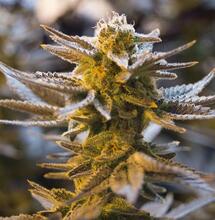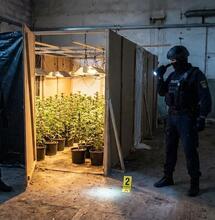Cannabinoid Functions in Our Bodies

Cannabinoid research for medicine is experiencing explosive growth; here is an outline of some cannabinoids and their effects on the body.
Cannabinoid research for medicine is experiencing explosive growth; here is an outline of some cannabinoids and their effects on the body.
|
Cannabinoid Functionality |
Science now accepts that we are born with endocannabinoids inside our bodies and a place for cannabinoids to function within our nervous system. Scientists now look for ways in which Cannabis can improve our health, rather than ways that the plant may hurt us. However, research is still hampered by legislation that is rooted in old-school ideas.
Pharmaceutical companies have marketed two cannabinoid medications for the treatment of poor appetite or nausea. Marinol is just synthetic tetrahydrocannabinol (THC). Sativex, marketed by GW Pharmaceuticals, is a combination of tetrahydrocannabinol and cannabidiol (CBD) in a carrier containing essential oils.
Tetrahydrocannabinol is also made by the Cannabis plant. The precursor chemicals geranyl pyrophosphate (GPP) and olivetolic acid (OA) are combined with the assistance of an enzyme made by Cannabis flowers to form cannabigerolic acid (CBGA). The Cannabis plant is able to manufacture the precursor chemicals and the cannabinoids it needs with nutrients from the soil and energy from the sun. Cannabigerolic acid can now be converted into several different cannabinoids that stimulate different effects within our bodies. The amount and type of cannabinoid is genetically predetermined by the individual Cannabis plant and plant strain.
Individual cannabinoid production is mediated in the plant by a specific enzyme and a specific enzyme pathway. One enzymatically-assisted reaction will form THCA or tetrahydrocannabinolic acid. Another reaction with a different enzyme will form cannabidiolic acid or CBDA. A third known reaction is assisted by a third enzyme forming CBCA or cannabichromenic acid. These cannabinoid acids are decarboxylated over time, through the action of oxygen and heat, to form THC, CBD and CBC. Decarboxylation changes and amplifies the biological effects of these compounds. A separate reaction between geranyl pyrophosphate and divarinolic acid can form THCVA, which decarboxylates into THCV.
CBN or cannabinol is not independently produced by Cannabis but rather is the result of THC degrading over time. Other cannabinoids and cannabinoid production pathways exist and others may still be discovered.
|
Most areas of the body contain cannabinoid receptors and are affected by either endo- or phytocannabinoids |
When ingested, THC will seek out CB1 and CB2 receptor sites in our nervous system. When THC binds to the receptor site on a cell membrane, the cell is stimulated into manufacturing certain chemical molecules. These chemicals then transport messages both within the cell and outside of the cell that circulate throughout the body to mediate feelings and processes. These naturally occurring CB1 and CB2 receptor sites exist to accommodate self-manufactured cannabinoids, anandamide (AEA) and 2-arachidonoylglycerol (2-AG). When anandamide or 2-AG bind to the receptors, they stimulate chemical production that is necessary for survival and existence. External cannabinoids can stimulate the same or similar responses as internal cannabinoids. The influence of the shape of the binding ligand determines the action of the chemical molecules formed.
Vincenzo Di Marzo summarized the endocannabinoid system in 1998 with the statement: "Relax, eat, sleep, protect and forget." Endocannabinoids are known for their ability to produce neurological changes that moderate pain and reduce anxiety. Endocannabinoids are part of our nervous system, which allows us to sleep via association with the endocannabinoids' role in regulation of our body energy system and peripheral metabolic processes. Endocannabinoids are involved in feelings of motivation, appetite (including appetite for specific foods) and digestion, plus formation of muscle, fat and bone. The implications are far-reaching. Because of the actions stimulated by the CB1 and CB2 receptor sites, cannabinoids can be utilized as medicines for pain and anxiety, weight gain and loss, autoimmune disease regulation, inflammation and muscle spasms. Cannabinoids can slow the progress of bacterial and fungal infections.
|
The spread of cancer in the body |
Cannabinoids have even been shown to stop the spread of cancer cells. When cancer cells form in an area of the body, cannabinoid receptor sites (CB1 and CB2) begin to form and multiply in the cancer cells and surrounding tissues. In the presence of cancer cells, Cannabis has been shown to release apoptosis-inducing substances that target the DNA of the cancer cells but leave surrounding cells unaffected. Scientists suspect that other chemical messengers mediated by CB2 receptor activity improve the resistance of healthy surrounding cells to cancerous attack - this is a natural form of chemotherapy that targets cancer cells but leaves healthy cells undisturbed. These results have been demonstrated in vitro to occur in lung, brain, breast and prostate tissue affected by cancer. The CB1 and CB2 receptor sites were stimulated into action by THC and CBD, instead of the natural ligands of anandamide or 2-AG.
Stimulation of CB1 and CB2 receptors suppresses feelings of nausea and the impulse to vomit. Appetite signals from the hypothalamus are mediated by endocannabinoids anandamide and 2-AG. Endocannabinoid signals stimulate appetite and the palatability of food. These signals stimulate the release of the neuropeptide ghrelin, which creates feelings of hunger and thoughts about eating. After eating, another neurotransmitter (cholecystokinin or CCK) is released by the duodenum to signal satiety. This suppresses CB1 receptor site activity which results in a decrease of appetite signals from the hypothalamus. Endocannabinoids mediate the release of leptin by adipose tissue; leptin is also an appetite suppressant. Endocannabinoids stimulate the liver to manufacture essential fatty acids (EFAs) and peripheral muscles to increase metabolic processes to burn calories.
|
Cannabinoids can treat a variety of ailments |
Cannabinoids are known to have antioxidant activity. The anti-inflammatory ability of cannabinoids is twice that of cortisone. The anxiolytic actions of the cannabinoids through the expression of the CB1 and CB2 receptor sites have been utilized in the treatment of PTSD by returning Armed Forces personnel. The ability of cannabinoids to help us forget traumatic experiences has also been investigated for developing treatments.
THCV, a cannabinoid found in Cannabis of central-Asian and southern-African origin, is being investigated as a treatment for obesity. In low doses, THCV acts as an antagonist and blockades the CB1 and CB2 receptor sites; however, in higher doses it binds and creates weight loss through suppression of appetite, reduction of blood glucose and increased energy expenditure and fat loss. This cannabinoid is currently being investigated as a treatment for obesity.
CBC (cannabichromene) has potential for analgesic activity and stimulation of brain and bone cell growth, plus anti-inflammatory and anti-cancer actions.



